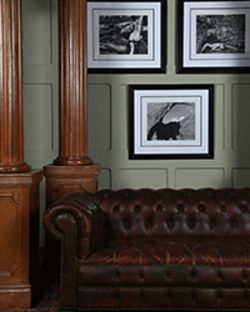λ HOSSEIN VALAMANESH (IRANIAN/AUSTRALIAN 1949-2022)
CHAI, AS CLOSE AS I COULD GET, 1998
MDF, enamel paint, fluorescent light, Perspex, water, glass, tea
Height 83cm (32½in.)
Edition of 5, plus A/P.
Hossein Valamanesh (1949-2022) was an Iranian-Australian artist particularly known for his work in sculpture and installation. Born in Tehran, Valamanesh emigrated to Perth after completing his artistic studies. He spent time in Aboriginal communities before settling in Adelaide, where he would rise to prominence. Valamanesh never lost sight of his native Persian culture, investing his works with commentary on identity and nationhood. The artist's œuvre is remarkable for its assured minimalism and use of natural materials, as well as poetry and calligraphic text. A learned, literary mind, Valamanesh never shrinks from grand ontological questions, employing circular motifs to reflect his belief in the unity of Man and nature. The artist suffered a heart attack in 1995, which prompted him to engage with themes of mortality and transience. Valamanesh is survived by his wife, Angela, with whom he undertook numerous public commissions. His works have been exhibited internationally, including at Grey Noise, Dubai, Galerie Tanit, Munich, and the Institut des Cultures d'Islam, Paris. Valamanesh's work can be found in all Australian state collections, as well as the Kadist Art Foundation, Paris, and the Sara Hildén Art Museum, Tampere. He is the recipient of numerous awards, such as the Grand Prize at the 8 th Asian Biennial (1997) and the Smithsonian Artist Research Fellowship (2014); in 2010, he was declared a Member of the Order of Australia.
It is no coincidence that Chai, as close as I could get figures prominently on the cover of the artist's 2011 monograph, Hossein Valamanesh: Out of Nothingness . The installation calls forth familiar descriptors: spiritual, ethereal, poetic, understated. Visually inspired by a glass floating in a bubbly sink, Chai embodies the humility one has come to expect of Valamanesh's work. (1) In accessible formal language, this installation invites the viewer to resolve its title. Whereto is Valamanesh getting close? How does Chai answer this question? The artist's practice owes itself to many quarters: Arte Povera, Persian poetry, Sufi philosophy, Aboriginal Australia. The diversity of Valamanesh's references reflects his own composite identity, while his use of tea conjures up associations with trade and travel. Chai may be read as an eloquent and at least partly autobiographical commentary on migration. The tea hovers above the water, bathing in its light. The brightness and purity of this arrangement elevate the everyday to an almost religious experience, recalling the Islamic practice of wuḍūʾ and baptismal fonts. Chai is a monument to the transubstantial process of uprooting and resettling, inspiring a sense of what critics have termed 'cosmopolitan belonging,' fraught and challenging though it may prove. (2) Here, tea and water have achieved comfortable, amicable proximity, though they will never make contact. Perhaps - as the unmixed liquids imply - total assimilation is unlikely. The tranquil equilibrium of Chai suggests that this is no cause for regret. Rather, as Valamanesh's life and work demonstrates, cultural integration is possible, desirable even, when one settles in a new land without ever losing sight of the first.
Here, the floating glass is held in delicate suspension, its contents recommending that we pause, sip, and breathe for a moment. As the great astrologer-poet Omar Khayyám once intoned, 'Each Morn a thousand Roses brings, you say: / Yes, but where leaves the Rose of Yesterday?' (3) This life is fleeting, yes, but so too is the fear of its end; Valamanesh invites us to embrace existence in all its beautiful fragility. Chai is not so much a memento mori , then, as a whispered carpe diem . To borrow the title of Valamanesh's first European retrospective, itself an allusion to Sufi poetry, Puisque tout passe : this too shall pass.
1. Mary Knights and Ian North, Hossein Valamanesh: Out of Nothingness (Kent Town, S. Aust.: Wakefield Press, 2011), 88.
2. Marsha Meskimmon, Contemporary Art and the Cosmopolitan Imagination (United Kingdom: Taylor & Francis, 2010), 86.
3. Omar Khayyám, Rubáiyát of Omar Khayyám , trans. Edward FitzGerald (United Kingdom: University Press of Virginia, 1997), 97.
Condition Report:
PLEASE NOTE: ALL LOTS IN THIS AUCTION ARE NOT AVAILABLE TO VIEW
Evidence of handling marks and dirt throughout. The glass has a small chip on the ring and the gilding has slightly faded. Otherwise good original condition throughout
PLEASE NOTE: ALL LOTS WILL BE AVAILABLE TO COLLECT FROM SACKVILLE WEST STORAGE IN ANDOVER, SP10 3SA, TWO DAYS AFTER THE AUCTION.
Condition Report Disclaimer

































































